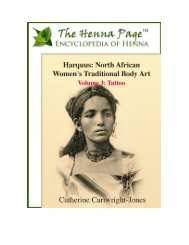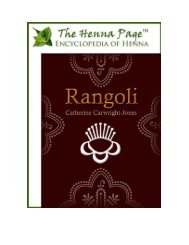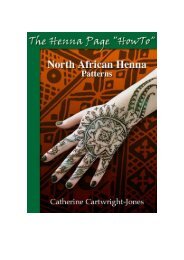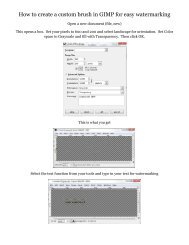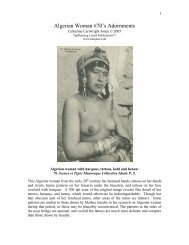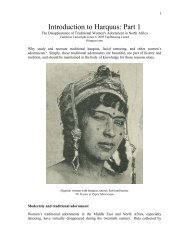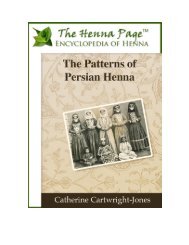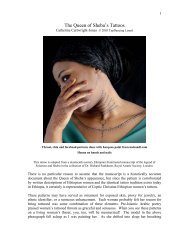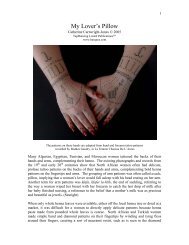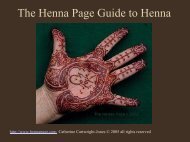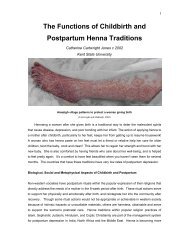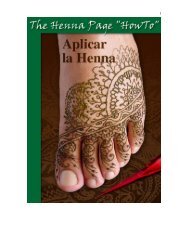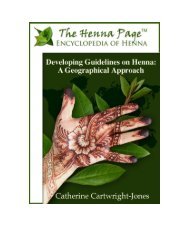Menstruation and Henna: Pollution and Purification - The Henna Page
Menstruation and Henna: Pollution and Purification - The Henna Page
Menstruation and Henna: Pollution and Purification - The Henna Page
Create successful ePaper yourself
Turn your PDF publications into a flip-book with our unique Google optimized e-Paper software.
Mohammed recommended it. Different sects <strong>and</strong> tribes had different henna <strong>and</strong> cleansing<br />
techniques, visual symbols, exorcisms, <strong>and</strong> rituals reflecting local culture. <strong>Henna</strong> was frequently<br />
part of postmenstrual ghusl, the purification bath, applied in patterns <strong>and</strong> techniques varying<br />
according to local taste.<br />
Islam did not create these concepts about reproductive blood <strong>and</strong> henna; Islam adapted pre-<br />
existing Semitic traditions. Islamic menstrual taboos were based on a concept of pollution <strong>and</strong><br />
vulnerability versus purity <strong>and</strong> strength. Menstruating women were vulnerable to jinn <strong>and</strong> the<br />
Evil Eye, irresistibly drawn to blood, particularly reproductive blood. <strong>The</strong>se evil forces caused<br />
fitna, or disorder, which manifested as disease, inappropriate conduct, <strong>and</strong> tragedy. <strong>Henna</strong><br />
contained baraka, or blessedness, which protected the wearer from misfortune. Women used<br />
henna <strong>and</strong> protective patterns drawn with henna to purify their bodies, to preserve the health of<br />
their skin <strong>and</strong> hair, <strong>and</strong> to protect their souls <strong>and</strong> minds from attack by malevolent spirits.<br />
Women negotiated their menstrual <strong>and</strong> reproductive vulnerability through henna, wearing visible<br />
symbols to show that they were pure, strong, in good spiritual st<strong>and</strong>ing, as well as in emotional<br />
<strong>and</strong> physical health.<br />
Western fashion <strong>and</strong> cosmetics changed henna use patterns in the 20 th century. North African <strong>and</strong><br />
Middle Eastern now often prefer the convenience <strong>and</strong> style of commercial nail polish <strong>and</strong> lotions<br />
to henna. Though there is a thriving henna tradition in Mauritania <strong>and</strong> Sudan, many<br />
contemporary Muslim women prefer to wear hijab <strong>and</strong> modest clothing to express their purity,<br />
<strong>and</strong> avoid henna because it seems old-fashioned <strong>and</strong> rural, or too much like tattooing (Messina<br />
1988).<br />
“<strong>Menstruation</strong> <strong>and</strong> <strong>Henna</strong>, <strong>Pollution</strong> <strong>and</strong> <strong>Purification</strong>”, was written by Catherine Cartwright-Jones as partial completion<br />
of the requirements for a Master’s degree in Liberal Studies focusing on henna, under the supervision of Dr. A Smith<br />
<strong>and</strong> Dr. N Ammar, Kent State University, Kent Ohio, USA<br />
4



